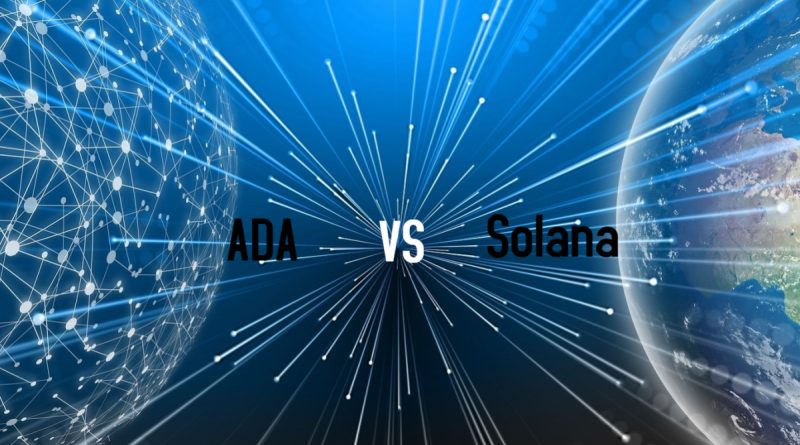Comparison between ADA and Solana
Snapshot
- Solana
- Cardano (ADA)
- Performance and Market Capitalization
- USPs
Solana
Solana is a layer 1 block chain protocol using Proof of History (POH) consensus mechanism. POH is used so that historical records of time, with time stamps could be created. Solana is capable of supporting up to 50,000 transactions per second, because of its hybrid consensus mechanism. On the first layer Solana is able to achieve huge computational power and is therefore in no need for any layer 2 scaling solutions. Development of smart contracts and decentralized applications or dApps is supported by blockchain and at present over 200 plus projects are powered with the Solana ecosystem and the same amount of projects are underway.
Cardano (ADA)
Cardano or ADA is a smart contract-enabled third generation protocol helping in the development of the DeFi ecosystem. Consensus mechanism that is used by ADA is Proof of Stake (PoS), which is a verification mechanism. In this users can stake their ADA tokens to participate in the validation process. This staking is only required when a ‘snapshot’ of the network is taken, and rest of the time they can be easily used to participate in DeFi, thus making this mechanism better then Proof of Stake.
RINA (Recursive Internetwork Architecture) technique is used to increase its transactional throughput, where the primary network is divided into smaller networks that communicate with each other.
Solana and Cardano are solving the same scalability issues even though Solana is a first layer solution and is new on DeFi. Solana has gained huge resistance because of its high transaction throughput. On the other hand, ADA is lagging due to the delay in its upgrades, such as the introduction of smart contracts.
Performance and Market Capitalization
The market capitalization of both blockchain platforms is in billions of dollars. In the global crypto market, Cardano is the fifth-largest cryptocurrency, whereas Solana is the sixth-largest cryptocurrency. The market cap for Cardano is $64.69 billion and that of Solana is $51.47 at the time of writing. In terms of trading volume, Cardano collects $2.64 billion in 24 hours and Solana has $2.82 billion in 24 hours.
In 2021, Solana witnessed a gain of 10,000%, from $2 at the start of the year to $200 at present; Cardano on the other hand witnessed growth over 1000%, from $0.18 at the start of the year to $2 at present.
Cardano’s rise can be linked to the recent involvement of smart contract features after Alonzo Hard fork. Simultaneously, Solana’s foray into the NFT domain with Degenerate Apes has triggered the present price surge.
USPs
Solana
- Number of validators active on its network is more than thousand, a number that has increased by about 100% in just a few months.
- Security mechanisms of the network are very rigid, with 75% of SOL tokens staked on the network, making it highly resistant to attacks.
- FTX.US, a popular cryptocurrency exchange, has announced the launch of an NFT marketplace on the protocol.
Cardano
- They have smart contracts capability which has grown the interest of DeFi platforms towards them.
- Through Ouroboros mechanism, users can have their own stacking pools or could delegate their ADAs to the existing one.
- The latest update scheduled for ADA, will split the base layer into CCL (Cardano Computational Layer) and CSL (Cardano Settlement Layer). This will provide more transparency and traceability to the platform and will also help in understanding why transactions are being carried out.
Proof-of-history vs. Proof-of-stake
Both Solana and Cardano address the issues of security, scalability and high energy consumption present there in Ethereum. Mechanism used by Solana is Proof of History and that by Cardano is an improved version of Proof of Stake called Ouroboros system.
Solana is capable of handling more than 50,000 transactions with the help of time stamps, thus lowering the weight of the data required for consensus. The PoH mechanism validates the transaction on the blockchain nodes themselves, reducing the workload.
Cardano validates the transaction by rewarding the validators on its staking system. The mechanism used in Cardano is a peer-reviewed and research based protocol using a mathematically verified mechanism to provide security to the Cardano network.
DeFi
Both are working hard for the adoption of DeFi by giving cheaper transactions and higher throughput. Smart contract integration is used by Cardano to increase its DeFi share. Cardano, through its venture capitalist organization EMURGO has invested $100 million to enhance its DeFi ecosystem.
Solana is climbing quickly in becoming the go to place for DeFis App utility. Port Finance and Solend both are Solana based projects and are competing to perform as decentralized banks.
Both blockchains are trying to build the same decentralized world and solve the same scalability issue. Both the blockchain have made significant growth in terms of technology.
Disclaimer: The article should not be considered as any financial advice. It is advisable to conduct thorough research before investment.
Photo by – 33cryptonews

